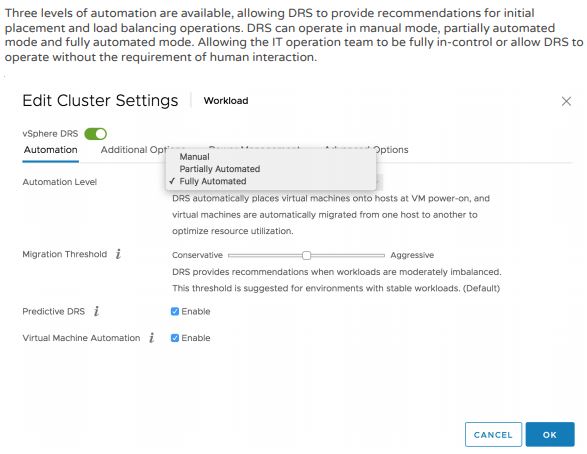
Distributed Resource Scheduler (DRS) is a resource management solution for vSphere clusters to provide optimized performance of application workloads. DRS will help you run the workloads efficiently on resources in a vSphere Environment .
Download the Official DRS White Paper# vSphere Resources and Availability
DRS will determine the current resource demand of workloads and the current resource availability of the ESXi host that are grouped into a single vSphere cluster. DRS provides recommendations throughout the life-cycle of the workload. From the moment, it is powered-on, to the moment it is powered-down.
DRS operations consist of generating initial placements and load balancing recommendations based on resource demand, business policies and energy-saving settings. It is able to automatically execute the initial placement and load balancing operations without any human interaction, allowing IT-organizations to focus their attention elsewhere.
DRS provides several additional benefits to IT operations:
DRS generates recommendations for initial placement of virtual machines on suitable ESXi hosts during power-on operations and generates load balancing recommendations for active workloads between ESXi hosts within the vSphere cluster. DRS leverages VMware vMotion technology for live migration of virtual machines. DRS responds to cluster and workload scaling operations and automatically generates resource relocation and optimization decisions as ESXi hosts or virtual machines are added or removed from the cluster. To enable the use of DRS migration recommendations, the ESXi hosts in the vSphere cluster must be part of a vMotion network. If the ESXi hosts are connected to the vMotion network, DRS can still make initial placement recommendations .
Clusters can consist of heterogeneous or homogeneous hardware configured ESXi hosts. ESXi hosts in a cluster can differ in capacity size. DRS allows hosts that have a different number of CPU packages or CPU cores, different memory or network capacity, but also different CPU generations. VMware Enhanced vMotion Compatibility (EVC) allows DRS to live migrate virtual machines between ESXi hosts with different CPU configurations of the same CPU vendor. DRS leverages EVC to manage placement and migration of virtual machines that have Fault Tolerance (FT) enabled.
DRS provides the ability contain virtual machines on selected hosts within the cluster by using VM to Host affinity groups for performance or availability purposes. DRS resource pools allow compartmentalizing cluster CPU and memory resources. A resource pool hierarchy allows resource isolation between resource pools and simultaneous optimal resource sharing within resource pools.
DRS Automation Levels
There are three levels of automation are available, allowing DRS to provide recommendations for initial placement and load balancing operations. DRS can operate in manual mode, partially automated mode and fully automated mode. Allowing the IT operation team to be fully in-control or allow DRS to operate without the requirement of human interaction.

Manual Automation Level
The manual automation level expects the IT operation team to be in complete control. DRS generates initial placement and load balancing recommendations and the IT operation team can choose to ignore the recommendation or to carry out any recommendations. If a virtual machine is powered-on on a DRS enabled cluster, DRS presents a list of mutually exclusive
initial placement recommendations for the virtual machine. If a cluster imbalance is detected during a DRS invocation, DRS presents a list of recommendations of virtual machine migrations to improve the cluster balance. With each subsequent DRS invocation, the state of the cluster is recalculated and a new list of recommendations could be generated
Partially Automated Level
DRS generates initial placement recommendations and executes them automatically. DRS generates load balancing operations for the IT operation teams to review and execute. Please note that the introduction of a new workload can impact current active workload, which may result in DRS generating load balancing recommendations. It is recommended to review the DRS recommendation list after power-on operations if the DRS cluster is configured to operate in partially automated mode.
Fully Automated Level
DRS operates autonomous in fully automated level mode and requires no human interaction. DRS generates initial placement and load balancing recommendations and executes these automatically. Please note that the migration threshold setting configures the aggressiveness of load balancing migrations.
Per-VM Automation Level
DRS allows Per-VM automation level to customize the automation level for individual virtual machines to override the cluster’s default automation level. This allows IT operation teams to still benefit from DRS at the cluster level while isolating particular virtual machines. This can be helpful if some virtual machines are not allowed to move due to licensing or strict performance requirement. DRS still considers the load utilization and requirements to meet the demand of these virtual machines during load balancing and initial placement operations, it just doesn’t move them around anymore.